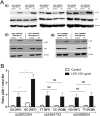Akt1 genetic variants confer increased susceptibility to thyroid cancer
- PMID: 33112820
- PMCID: PMC7774771
- DOI: 10.1530/EC-20-0311
Akt1 genetic variants confer increased susceptibility to thyroid cancer
Abstract
The PI3K-Akt-mTOR pathway plays a central role in the development of non-medullary thyroid carcinoma (NMTC). Although somatic mutations have been identified in these genes in NMTC patients, the role of germline variants has not been investigated. Here, we selected frequently occurring genetic variants in AKT1, AKT2, AKT3, PIK3CA and MTOR and have assessed their effect on NMTC susceptibility, progression and clinical outcome in a Dutch discovery cohort (154 patients, 188 controls) and a Romanian validation cohort (159 patients, 260 controls). Significant associations with NMTC susceptibility were observed for AKT1 polymorphisms rs3803304, rs2494732 and rs2498804 in the Dutch discovery cohort, of which the AKT1 rs3803304 association was confirmed in the Romanian validation cohort. No associations were observed between PI3K-Akt-mTOR polymorphisms and clinical parameters including histology, TNM staging, treatment response and clinical outcome. Functionally, cells bearing the associated AKT1 rs3803304 risk allele exhibit increased levels of phosphorylated Akt protein, potentially leading to elevated signaling activity of the oncogenic Akt pathway. All together, germline encoded polymorphisms in the PI3K-Akt-mTOR pathway could represent important risk factors in development of NMTC.
Keywords: PI3K/Akt/mTOR; genetic variation; non-medullary thyroid cancer; susceptibility.
Figures

Similar articles
-
A comprehensive immunohistochemical and molecular approach to the PI3K/AKT/mTOR (phosphoinositide 3-kinase/v-akt murine thymoma viral oncogene/mammalian target of rapamycin) pathway in bladder urothelial carcinoma.BJU Int. 2012 Dec;110(11 Pt C):E1237-48. doi: 10.1111/j.1464-410X.2012.11569.x. Epub 2012 Oct 29. BJU Int. 2012. PMID: 23107319
-
Association of NF-κB polymorphisms with clinical outcome of non-medullary thyroid carcinoma.Endocr Relat Cancer. 2017 Jul;24(7):307-318. doi: 10.1530/ERC-17-0033. Epub 2017 Apr 20. Endocr Relat Cancer. 2017. PMID: 28428267
-
Associations between single-nucleotide polymorphisms in the PI3K-PTEN-AKT-mTOR pathway and increased risk of brain metastasis in patients with non-small cell lung cancer.Clin Cancer Res. 2013 Nov 15;19(22):6252-60. doi: 10.1158/1078-0432.CCR-13-1093. Epub 2013 Sep 27. Clin Cancer Res. 2013. PMID: 24077347
-
Genetic susceptibility to hereditary non-medullary thyroid cancer.Hered Cancer Clin Pract. 2022 Mar 7;20(1):9. doi: 10.1186/s13053-022-00215-3. Hered Cancer Clin Pract. 2022. PMID: 35255942 Free PMC article. Review.
-
Activation of PI3K/Akt/mTOR pathway and dual inhibitors of PI3K and mTOR in endometrial cancer.Curr Med Chem. 2014;21(26):3070-80. doi: 10.2174/0929867321666140414095605. Curr Med Chem. 2014. PMID: 24735369 Review.
Cited by
-
Autophagy-Related MicroRNA: Tumor miR-125b and Thyroid Cancers.Genes (Basel). 2023 Mar 9;14(3):685. doi: 10.3390/genes14030685. Genes (Basel). 2023. PMID: 36980957 Free PMC article.
-
AKT1 Functional Polymorphism (rs2494750) Influences Clinical Outcomes in Patients With Advanced Lung Cancer Treated With EGFR Inhibitors.J Korean Med Sci. 2025 Aug 11;40(31):e184. doi: 10.3346/jkms.2025.40.e184. J Korean Med Sci. 2025. PMID: 40795341 Free PMC article.
-
mTOR pathway candidate genes and obesity interaction on breast cancer risk in black women from the Women's Circle of Health Study.Cancer Causes Control. 2023 May;34(5):431-447. doi: 10.1007/s10552-022-01657-9. Epub 2023 Feb 15. Cancer Causes Control. 2023. PMID: 36790512 Free PMC article.
-
mTOR pathway candidate genes and energy intake interaction on breast cancer risk in Black women from the Women's Circle of Health Study.Eur J Nutr. 2023 Sep;62(6):2593-2604. doi: 10.1007/s00394-023-03176-y. Epub 2023 May 20. Eur J Nutr. 2023. PMID: 37209192 Free PMC article.
References
LinkOut - more resources
Full Text Sources
Miscellaneous

